08 Python 3 - Loops
In general, statements are executed sequentially − The first statement in a function is executed first, followed by the second, and so on. There may be a situation when you need to execute a block of code several number of times.
Programming languages provide various control structures that allow more complicated execution paths.
A loop statement allows us to execute a statement or group of statements multiple times. The following diagram illustrates a loop statement −
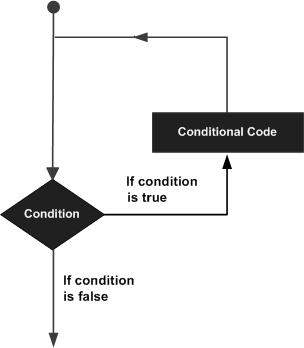
Python programming language provides the following types of loops to handle looping requirements.
| Sr.No. | Loop Type & Description |
|---|---|
| 1 | while loop
Repeats a statement or group of statements while a given condition is TRUE. It tests the condition before executing the loop body. |
| 2 | for loop
Executes a sequence of statements multiple times and abbreviates the code that manages the loop variable. |
| 3 | nested loops
You can use one or more loop inside any another while, or for loop. |
Loop Control Statements
The Loop control statements change the execution from its normal sequence. When the execution leaves a scope, all automatic objects that were created in that scope are destroyed.
Python supports the following control statements.
| Sr.No. | Control Statement & Description |
|---|---|
| 1 | break statement
Terminates the loop statement and transfers execution to the statement immediately following the loop. |
| 2 | continue statement
Causes the loop to skip the remainder of its body and immediately retest its condition prior to reiterating. |
| 3 | pass statement
The pass statement in Python is used when a statement is required syntactically but you do not want any command or code to execute. |
Let us go through the loop control statements briefly.
Iterator and Generator
Iterator is an object which allows a programmer to traverse through all the elements of a collection, regardless of its specific implementation. In Python, an iterator object implements two methods, iter() and next().
String, List or Tuple objects can be used to create an Iterator.
#!/usr/bin/python3
import sys
list = [1,2,3,4]
it = iter(list) # this builds an iterator object
print (next(it)) #prints next available element in iterator
#Iterator object can be traversed using regular for statement
for x in it:
print (x, end=" ")
#or using next() function
while True:
try:
print (next(it))
except StopIteration:
sys.exit()
A generator is a function that produces or yields a sequence of values using yield method.
When a generator function is called, it returns a generator object without even beginning execution of the function. When the next() method is called for the first time, the function starts executing until it reaches the yield statement, which returns the yielded value. The yield keeps track i.e. remembers the last execution and the second next() call continues from previous value.
Example
The following example defines a generator, which generates an iterator for all the Fibonacci numbers.
#!usr/bin/python3
import sys
def fibonacci(n): #generator function
a, b, counter = 0, 1, 0
while True:
if (counter > n):
return
yield a
a, b = b, a + b
counter += 1
f = fibonacci(5) #f is iterator object
while True:
try:
print (next(f), end=" ")
except StopIteration:
sys.exit()
Python 3 - while Loop Statements
A while loop statement in Python programming language repeatedly executes a target statement as long as a given condition is true.
Syntax
The syntax of a while loop in Python programming language is −
while expression: statement(s)
Here, statement(s) may be a single statement or a block of statements with uniform indent. The condition may be any expression, and true is any non-zero value. The loop iterates while the condition is true.
When the condition becomes false, program control passes to the line immediately following the loop.
In Python, all the statements indented by the same number of character spaces after a programming construct are considered to be part of a single block of code. Python uses indentation as its method of grouping statements.
Flow Diagram
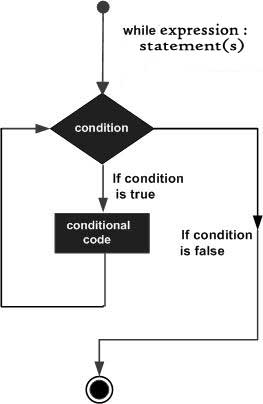
Here, a key point of the while loop is that the loop might not ever run. When the condition is tested and the result is false, the loop body will be skipped and the first statement after the while loop will be executed.
Example
#!/usr/bin/python3
count = 0
while (count < 9):
print ('The count is:', count)
count = count + 1
print ("Good bye!")
Output
When the above code is executed, it produces the following result −
The count is: 0 The count is: 1 The count is: 2 The count is: 3 The count is: 4 The count is: 5 The count is: 6 The count is: 7 The count is: 8 Good bye!
The block here, consisting of the print and increment statements, is executed repeatedly until count is no longer less than 9. With each iteration, the current value of the index count is displayed and then increased by 1.
The Infinite Loop
A loop becomes infinite loop if a condition never becomes FALSE. You must be cautious when using while loops because of the possibility that this condition never resolves to a FALSE value. This results in a loop that never ends. Such a loop is called an infinite loop.
An infinite loop might be useful in client/server programming where the server needs to run continuously so that client programs can communicate with it as and when required.
Example
#!/usr/bin/python3
var = 1
while var == 1 : # This constructs an infinite loop
num = int(input("Enter a number :"))
print ("You entered: ", num)
print ("Good bye!")
Output
When the above code is executed, it produces the following result −
Enter a number :20
You entered: 20
Enter a number :29
You entered: 29
Enter a number :3
You entered: 3
Enter a number :11
You entered: 11
Enter a number :22
You entered: 22
Enter a number :Traceback (most recent call last):
File "examples\test.py", line 5, in
num = int(input("Enter a number :"))
KeyboardInterrupt
The above example goes in an infinite loop and you need to use CTRL+C to exit the program.
Using else Statement with Loops
Python supports having an else statement associated with a loop statement.
-
If the else statement is used with a for loop, the else statement is executed when the loop has exhausted iterating the list.
-
If the else statement is used with a while loop, the else statement is executed when the condition becomes false.
The following example illustrates the combination of an else statement with a while statement that prints a number as long as it is less than 5, otherwise the else statement gets executed.
Example
#!/usr/bin/python3
count = 0
while count < 5:
print (count, " is less than 5")
count = count + 1
else:
print (count, " is not less than 5")
Output
When the above code is executed, it produces the following result −
0 is less than 5 1 is less than 5 2 is less than 5 3 is less than 5 4 is less than 5 5 is not less than 5
Single Statement Suites
Similar to the if statement syntax, if your while clause consists only of a single statement, it may be placed on the same line as the while header.
Example
Here is the syntax and example of a one-line while clause −
#!/usr/bin/python3
flag = 1
while (flag): print ('Given flag is really true!')
print ("Good bye!")
The above example goes into an infinite loop and you need to press CTRL+C keys to exit.
Python 3 - for Loop Statements
The for statement in Python has the ability to iterate over the items of any sequence, such as a list or a string.
Syntax
for iterating_var in sequence: statements(s)
If a sequence contains an expression list, it is evaluated first. Then, the first item in the sequence is assigned to the iterating variable iterating_var. Next, the statements block is executed. Each item in the list is assigned to iterating_var, and the statement(s) block is executed until the entire sequence is exhausted.
Flow Diagram
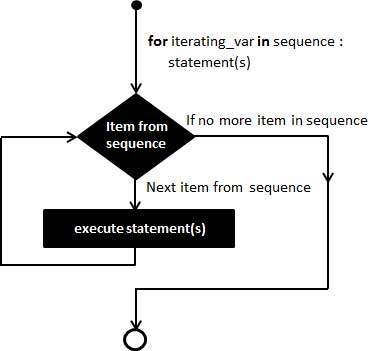
The range() function
The built-in function range() is the right function to iterate over a sequence of numbers. It generates an iterator of arithmetic progressions.
Example
>>> range(5)
range(0, 5)
>>> list(range(5))
[0, 1, 2, 3, 4]
Example
range() generates an iterator to progress integers starting with 0 upto n-1. To obtain a list object of the sequence, it is typecasted to list(). Now this list can be iterated using the for statement.
>>> for var in list(range(5)):
print (var)
Output
This will produce the following output.
0 1 2 3 4
Example
#!/usr/bin/python3
for letter in 'Python': # traversal of a string sequence
print ('Current Letter :', letter)
print()
fruits = ['banana', 'apple', 'mango']
for fruit in fruits: # traversal of List sequence
print ('Current fruit :', fruit)
print ("Good bye!")
Output
When the above code is executed, it produces the following result −
Current Letter : P Current Letter : y Current Letter : t Current Letter : h Current Letter : o Current Letter : n Current fruit : banana Current fruit : apple Current fruit : mango Good bye!
Iterating by Sequence Index
An alternative way of iterating through each item is by index offset into the sequence itself. Following is a simple example −
Example
#!/usr/bin/python3
fruits = ['banana', 'apple', 'mango']
for index in range(len(fruits)):
print ('Current fruit :', fruits[index])
print ("Good bye!")
Output
When the above code is executed, it produces the following result −
Current fruit : banana Current fruit : apple Current fruit : mango Good bye!
Here, we took the assistance of the len() built-in function, which provides the total number of elements in the tuple as well as the range() built-in function to give us the actual sequence to iterate over.
Using else Statement with Loops
Python supports having an else statement associated with a loop statement.
-
If the else statement is used with a for loop, the else block is executed only if for loops terminates normally (and not by encountering break statement).
-
If the else statement is used with a while loop, the else statement is executed when the condition becomes false.
Example
The following example illustrates the combination of an else statement with a for statement that searches for even number in given list.
#!/usr/bin/python3
numbers = [11,33,55,39,55,75,37,21,23,41,13]
for num in numbers:
if num%2 == 0:
print ('the list contains an even number')
break
else:
print ('the list doesnot contain even number')
Output
When the above code is executed, it produces the following result −
the list does not contain even number
Python 3 - Nested loops
Python programming language allows the usage of one loop inside another loop. The following section shows a few examples to illustrate the concept.
Syntax
for iterating_var in sequence:
for iterating_var in sequence:
statements(s)
statements(s)
The syntax for a nested while loop statement in Python programming language is as follows −
while expression:
while expression:
statement(s)
statement(s)
A final note on loop nesting is that you can put any type of loop inside any other type of loop. For example a for loop can be inside a while loop or vice versa.
Example
The following program uses a nested-for loop to display multiplication tables from 1-10.
#!/usr/bin/python3
import sys
for i in range(1,11):
for j in range(1,11):
k = i*j
print (k, end=' ')
print()
The print() function inner loop has end=' ' which appends a space instead of default newline. Hence, the numbers will appear in one row.
Last print() will be executed at the end of inner for loop.
Output
When the above code is executed, it produces the following result −
1 2 3 4 5 6 7 8 9 10 2 4 6 8 10 12 14 16 18 20 3 6 9 12 15 18 21 24 27 30 4 8 12 16 20 24 28 32 36 40 5 10 15 20 25 30 35 40 45 50 6 12 18 24 30 36 42 48 54 60 7 14 21 28 35 42 49 56 63 70 8 16 24 32 40 48 56 64 72 80 9 18 27 36 45 54 63 72 81 90 10 20 30 40 50 60 70 80 90 100
Python 3 - break statement
The break statement is used for premature termination of the current loop. After abandoning the loop, execution at the next statement is resumed, just like the traditional break statement in C.
The most common use of break is when some external condition is triggered requiring a hasty exit from a loop. The break statement can be used in both while and for loops.
If you are using nested loops, the break statement stops the execution of the innermost loop and starts executing the next line of the code after the block.
Syntax
The syntax for a break statement in Python is as follows −
break
Flow Diagram
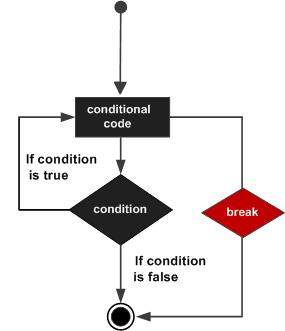
Example
#!/usr/bin/python3
for letter in 'Python': # First Example
if letter == 'h':
break
print ('Current Letter :', letter)
var = 10 # Second Example
while var > 0:
print ('Current variable value :', var)
var = var -1
if var == 5:
break
print ("Good bye!")
Output
When the above code is executed, it produces the following result −
Current Letter : P Current Letter : y Current Letter : t Current variable value : 10 Current variable value : 9 Current variable value : 8 Current variable value : 7 Current variable value : 6 Good bye!
The following program demonstrates use of the break in a for loop iterating over a list. User inputs a number, which is searched in the list. If it is found, then the loop terminates with the 'found' message.
Example
#!/usr/bin/python3
no = int(input('any number: '))
numbers = [11,33,55,39,55,75,37,21,23,41,13]
for num in numbers:
if num == no:
print ('number found in list')
break
else:
print ('number not found in list')
Output
The above program will produce the following output −
any number: 33 number found in list any number: 5 number not found in list
Python 3 - continue statement
The continue statement in Python returns the control to the beginning of the current loop. When encountered, the loop starts next iteration without executing the remaining statements in the current iteration.
The continue statement can be used in both while and for loops.
Syntax
continue
Flow Diagram
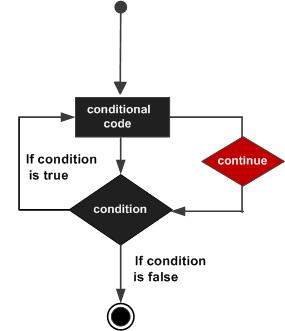
Example
#!/usr/bin/python3
for letter in 'Python': # First Example
if letter == 'h':
continue
print ('Current Letter :', letter)
var = 10 # Second Example
while var > 0:
var = var -1
if var == 5:
continue
print ('Current variable value :', var)
print ("Good bye!")
Output
When the above code is executed, it produces the following result −
Current Letter : P Current Letter : y Current Letter : t Current Letter : o Current Letter : n Current variable value : 9 Current variable value : 8 Current variable value : 7 Current variable value : 6 Current variable value : 4 Current variable value : 3 Current variable value : 2 Current variable value : 1 Current variable value : 0 Good bye!
Python 3 - pass Statement
It is used when a statement is required syntactically but you do not want any command or code to execute.
The pass statement is a null operation; nothing happens when it executes. The pass statement is also useful in places where your code will eventually go, but has not been written yet i.e. in stubs.
Syntax
pass
Example
#!/usr/bin/python3
for letter in 'Python':
if letter == 'h':
pass
print ('This is pass block')
print ('Current Letter :', letter)
print ("Good bye!")
Output
When the above code is executed, it produces the following result −
Current Letter : P Current Letter : y Current Letter : t This is pass block Current Letter : h Current Letter : o Current Letter : n Good bye!
https://www.tutorialspoint.com/python3/python_loops.htm

